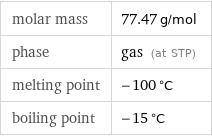Input interpretation

chlorine azide
Chemical names and formulas

formula | ClN_3 name | chlorine azide alternate names | chlorine nitride | nitrogen chloride mass fractions | Cl (chlorine) 45.8% | N (nitrogen) 54.2%
Lewis structure

Draw the Lewis structure of chlorine azide. Start by drawing the overall structure of the molecule, ignoring potential double and triple bonds: Count the total valence electrons of the chlorine (n_Cl, val = 7) and nitrogen (n_N, val = 5) atoms: n_Cl, val + 3 n_N, val = 22 Calculate the number of electrons needed to completely fill the valence shells for chlorine (n_Cl, full = 8) and nitrogen (n_N, full = 8): n_Cl, full + 3 n_N, full = 32 Subtracting these two numbers shows that 32 - 22 = 10 bonding electrons are needed. Each bond has two electrons, so in addition to the 3 bonds already present in the diagram add 2 bonds. To minimize formal charge nitrogen wants 3 bonds. Identify the atoms that want additional bonds and the number of electrons remaining on each atom: To fully fill its valence shell, nitrogen will donate one of its electrons, allowing it to form four bonds (the maximum number an element on period 2 can form). Fill in the 2 bonds by pairing electrons between adjacent highlighted atoms, noting the formal charges of the atoms: Answer: | |
3D structure

3D structure
Basic properties

molar mass | 77.47 g/mol phase | gas (at STP) melting point | -100 °C boiling point | -15 °C
Units

Chemical identifiers
![CAS number | 13973-88-1 PubChem CID number | 61708 SMILES identifier | [N-]=[N+]=NCl InChI identifier | InChI=1/ClN3/c1-3-4-2 Gmelin number | 1505](../image_source/5b2dcaf52e7d153cb171308880825524.png)
CAS number | 13973-88-1 PubChem CID number | 61708 SMILES identifier | [N-]=[N+]=NCl InChI identifier | InChI=1/ClN3/c1-3-4-2 Gmelin number | 1505
Ion equivalents

Cl^- (chloride anion) | 1 (N_3)^- (azide anion) | 1